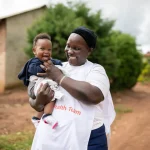Posted on: August 5, 2025
By Richard Muhumuza, Senior Manager, Projects and Service Delivery, Living Goods – Uganda
As we enter the final quarter of the Building Integrated Readiness for Community Health (BIRCH) project, I’ve found myself reflecting deeply on what we’ve accomplished, what we’ve learned, and where we must go next.
Funded by The Global Fund and supported technically by Africa Frontline First, BIRCH set out with an ambitious vision: to lay a strong foundation for a country-led, well-integrated, and sustainable community health system in Uganda, one where community health workers (CHWs) are equipped with the tools, support, and structures they need to deliver impact.
What has made this project special is not just what we’ve done, but how we’ve done it.
From the outset, BIRCH was never about bringing in a pre-packaged solution. Instead, we engaged the Ministry of Health and implementing partners as equal co-creators, sitting together to design interventions aligned with national priorities. That approach may sound obvious, but in practice, it demands deep intentionality, trust, and flexibility.
By prioritizing local ownership, we’ve seen stronger government buy-in, smoother alignment with national strategies, and greater potential for long-term sustainability. The Ministry isn’t just participating, they’re leading.
“We’re not solving our own pain points, we’re meaningfully addressing the Ministry’s needs and priorities,” I often say. And that’s a key reason why BIRCH has gained such traction.
Building accountability into the system
One of the most exciting shifts BIRCH has catalyzed is how we track and account for community health investments. We’re now moving beyond assumptions. Through quarterly investment tracking, we’re starting to see who is contributing, how much, and where the gaps are.
This visibility is powerful. It’s allowing for more informed decisions, smarter resource allocation, and timely course correction. In short, we’re bringing real-time accountability into a space that has long suffered from fragmented data and delayed action.
Of course, no project of this scale is without its challenges. One of the trickiest has been ensuring effective coordination, both within the Ministry of Health and among partners. Ministries are incredibly busy, and for any new initiative to succeed, it must be prioritized within an already packed agenda.
We’ve learned that this takes patience, strategic timing, and sustained engagement. It also requires building internal champions and finding the right moments to push ideas forward.
The momentum we’ve built wouldn’t be possible without our partners. The Ministry of Health, Africa Frontline First, and Global Fund have all played critical roles, from providing stewardship and technical guidance to facilitating valuable South-to-South learning opportunities.
Internally, I’ve been fortunate to work alongside incredible colleagues. our Country Director, Christine Namayanja, Dr. Stella Kanyerere, Director Program Delivery, and Amy Kakiza the Director Partnerships and Advocacy, among others, have brought unwavering commitment and strategic insight that has kept us focused and agile. Their contributions have ensured that accountability remains a core pillar of everything we do.
At Living Goods, we believe in learning while doing. With BIRCH, we’ve institutionalized that mindset, documenting learnings in real time, capturing emerging insights, and sharing them widely. That includes all of you, our ambassadors, peers, and sector leaders. Because if these lessons stay in folders, they won’t shape the future we’re all working toward.
Looking ahead: The unfinished work
While the BIRCH project may be approaching its conclusion, the real work continues.
In today’s fiscal climate, where global health resources are becoming increasingly constrained, we must double down on what works. Local ownership, strong coordination, transparent planning, and adaptive learning are not optional. They’re essential.
We’ve laid important groundwork. Now, we must ensure that our insights inform what comes next, not just in Uganda, but across the global community health landscape.
“We’ve already made important steps,” I often remind myself and my team. “Now we need to build on them and make sure our learnings don’t sit in folders but shape the decisions of tomorrow.”

